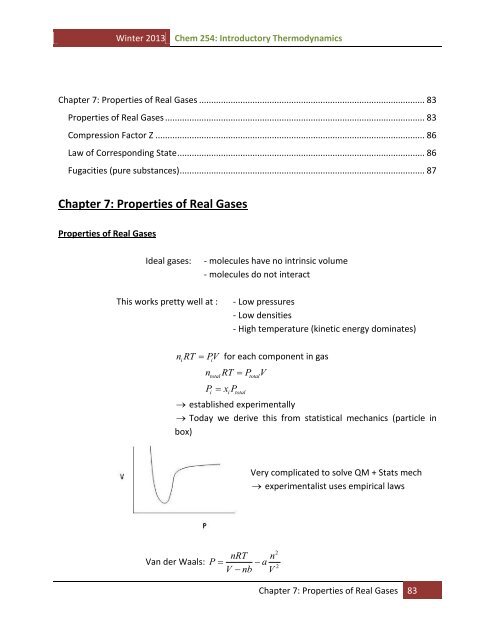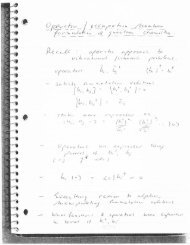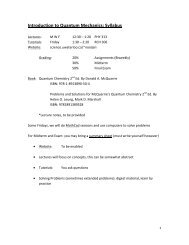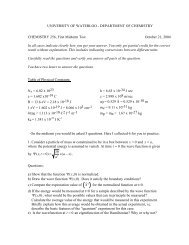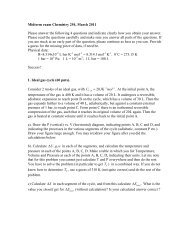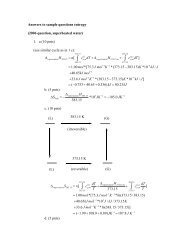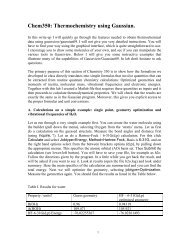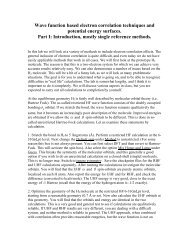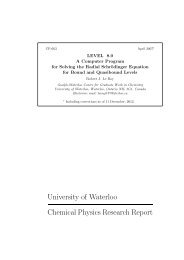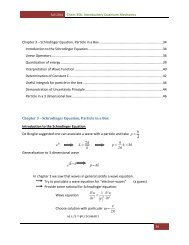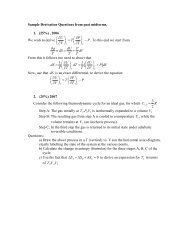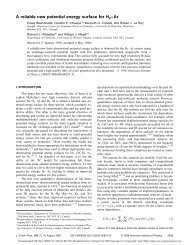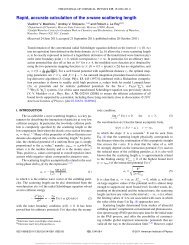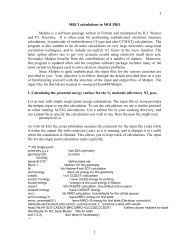Chapter 7: Properties of Real Gases
Chapter 7: Properties of Real Gases
Chapter 7: Properties of Real Gases
Create successful ePaper yourself
Turn your PDF publications into a flip-book with our unique Google optimized e-Paper software.
Winter 2013<br />
Chem 254: Introductory Thermodynamics<br />
<strong>Chapter</strong> 7: <strong>Properties</strong> <strong>of</strong> <strong>Real</strong> <strong>Gases</strong> ............................................................................................. 83<br />
<strong>Properties</strong> <strong>of</strong> <strong>Real</strong> <strong>Gases</strong> ........................................................................................................... 83<br />
Compression Factor Z ............................................................................................................... 86<br />
Law <strong>of</strong> Corresponding State ...................................................................................................... 86<br />
Fugacities (pure substances) ..................................................................................................... 87<br />
<strong>Chapter</strong> 7: <strong>Properties</strong> <strong>of</strong> <strong>Real</strong> <strong>Gases</strong><br />
<strong>Properties</strong> <strong>of</strong> <strong>Real</strong> <strong>Gases</strong><br />
Ideal gases:<br />
- molecules have no intrinsic volume<br />
- molecules do not interact<br />
This works pretty well at :<br />
- Low pressures<br />
- Low densities<br />
- High temperature (kinetic energy dominates)<br />
n RT PV for each component in gas<br />
i<br />
i<br />
n RT P V<br />
total<br />
P x P<br />
i i total<br />
total<br />
established experimentally<br />
Today we derive this from statistical mechanics (particle in<br />
box)<br />
Very complicated to solve QM + Stats mech<br />
experimentalist uses empirical laws<br />
Van der Waals:<br />
nRT n<br />
P a<br />
V nb V<br />
2<br />
2<br />
<strong>Chapter</strong> 7: <strong>Properties</strong> <strong>of</strong> <strong>Real</strong> <strong>Gases</strong> 83
Winter 2013<br />
Chem 254: Introductory Thermodynamics<br />
Redlich-Kwong:<br />
Virial equation <strong>of</strong> State (systematic)<br />
2<br />
nRT n a 1<br />
P V nb T V nb<br />
1 B( T) C( T)<br />
<br />
P RT ....<br />
V<br />
2 <br />
m V<br />
m V<br />
m <br />
BT ( ): power series in T<br />
<br />
<br />
V<br />
m<br />
V<br />
<br />
n<br />
for a range <strong>of</strong> volumes (condensation), pressure is<br />
the same<br />
no way to fit against analytical function<br />
Ideal gas: cannot capture gas liquid transition<br />
Van der Waals<br />
nRT n<br />
P a<br />
V nb V<br />
2<br />
2<br />
2 2 2<br />
<br />
P V nb V nRTV an V nb<br />
3 2 2 2 2<br />
PV PnbV nRTV an V an b 0<br />
solve cubic equation for V :<br />
x<br />
<br />
x x 1 2 0 x 0,1, 2<br />
<br />
<br />
2<br />
x x 1 0 x 0,<br />
i;<br />
2<br />
i <br />
1<br />
From VDW cubic solution construct the<br />
flat region <strong>of</strong> graph<br />
<strong>Chapter</strong> 7: <strong>Properties</strong> <strong>of</strong> <strong>Real</strong> <strong>Gases</strong> 84
Winter 2013<br />
Chem 254: Introductory Thermodynamics<br />
T c<br />
at which<br />
P<br />
<br />
P<br />
<br />
V<br />
<br />
<br />
Tc<br />
2<br />
0<br />
2 <br />
V<br />
Tc<br />
Do the calculation:<br />
8a<br />
Tc<br />
ab , are VDW parameters<br />
27Rb<br />
a<br />
Pc<br />
<br />
2<br />
27b<br />
V b<br />
mc ,<br />
3<br />
What if T<br />
T <br />
c<br />
Increase density, but all in one supercritical<br />
phase (no phase transition)<br />
<strong>Chapter</strong> 7: <strong>Properties</strong> <strong>of</strong> <strong>Real</strong> <strong>Gases</strong> 85
Winter 2013<br />
Chem 254: Introductory Thermodynamics<br />
Compression Factor Z<br />
V PV<br />
Z <br />
V RT<br />
actual<br />
m<br />
ideal<br />
m<br />
V<br />
Vm<br />
<br />
n<br />
ideal RT<br />
Vm<br />
<br />
P<br />
Z : tabulated for many gases<br />
m<br />
Low T , low P , Z 1,<br />
V<br />
m<br />
V<br />
High T , (very) high P , Z 1,<br />
ideal<br />
m<br />
V<br />
m<br />
attraction dominates<br />
V<br />
ideal<br />
m<br />
finite volume term dominates<br />
Law <strong>of</strong> Corresponding State<br />
-reduced, dimensionless variables<br />
T<br />
r<br />
T<br />
, Pr<br />
T<br />
c<br />
P<br />
, V<br />
,<br />
P<br />
c<br />
mr<br />
V<br />
<br />
V<br />
m<br />
mc ,<br />
T , P , V<br />
c c m,<br />
c<br />
= parameters for specific gas<br />
Van der Waals has a unique form:<br />
T<br />
c<br />
8T<br />
3<br />
Pr<br />
<br />
3V<br />
1<br />
r<br />
2<br />
mr ,<br />
Vmr<br />
,<br />
same for every gas<br />
8a<br />
a<br />
, Pc<br />
, V<br />
2 mc ,<br />
3b<br />
ab , = VDW parameters<br />
27Rb<br />
27b<br />
actual<br />
Vm<br />
For any gas: Plot Z vs T ,<br />
ideal r<br />
P<br />
r<br />
V<br />
c<br />
c<br />
m<br />
virtually the same plot for any gas (not exactly)<br />
know T , P for gas, use numerical curve to get V<br />
mr ,<br />
(figure 7.8 in book)<br />
Example:<br />
1.00 kg <strong>of</strong> CH4<br />
at T 200 K, P 68 , V <br />
<strong>Chapter</strong> 7: <strong>Properties</strong> <strong>of</strong> <strong>Real</strong> <strong>Gases</strong> 86
Winter 2013<br />
Chem 254: Introductory Thermodynamics<br />
1 kg<br />
16.09 10 kg mol<br />
n <br />
3 1<br />
ideal nRT<br />
Vm<br />
17.52 L<br />
P<br />
Table 7.2 in book CH<br />
4<br />
Tc<br />
190.56 K , Pc<br />
45.99 bar<br />
T<br />
r<br />
T<br />
P<br />
1.21 Pr<br />
1.48<br />
T<br />
P<br />
c<br />
look at figure 7.8 <br />
c<br />
Z T , P 0.63<br />
ideal<br />
V ZV m<br />
0.6317.52 L 11.04 L<br />
r<br />
r<br />
Two gases with the same T , P have the same V<br />
,<br />
r<br />
r<br />
mr<br />
Fugacities (pure substances)<br />
o<br />
For ideal gases <br />
P <br />
T, P T RT<br />
ln , where<br />
Po<br />
<br />
substance at pressure P<br />
o<br />
= 1bar. This is not really correct<br />
o<br />
is for the pure<br />
<strong>Real</strong> gases<br />
Pf<br />
Pi<br />
d V dP (constant T )<br />
m<br />
ideal RT<br />
Vm<br />
<br />
P<br />
RT<br />
d dP<br />
P<br />
P P <br />
d<br />
RT dP RT ln <br />
Po<br />
Po<br />
<br />
<br />
V<br />
m<br />
ZV<br />
ideal<br />
m<br />
ideal<br />
V Z 1 V<br />
m<br />
<br />
<br />
ideal<br />
m<br />
RT RT<br />
Z<br />
1<br />
P P<br />
dP<br />
RT<br />
d VmdP RT RT Z 1<br />
dP<br />
P<br />
P<br />
Pf<br />
P P P<br />
<br />
Pi Po Po Po<br />
P <br />
RT ln RT<br />
ln <br />
Po<br />
<br />
= fugacity coefficient (calculated from integral)<br />
<strong>Chapter</strong> 7: <strong>Properties</strong> <strong>of</strong> <strong>Real</strong> <strong>Gases</strong> 87
Winter 2013<br />
Chem 254: Introductory Thermodynamics<br />
Fugacity: f P<br />
f is like pressure, correction for non ideal gas behavior<br />
<br />
P <br />
T, P T, Po<br />
RT<br />
ln <br />
Po<br />
<br />
f <br />
T, Po<br />
RT<br />
ln <br />
Po<br />
<br />
Back to chemical equilibrium<br />
G<br />
<br />
<br />
<br />
<br />
TP ,<br />
<br />
<br />
<br />
T,<br />
P<br />
i<br />
i<br />
o<br />
f <br />
i<br />
rGT<br />
RT ln <br />
Po<br />
<br />
o<br />
0 G RT ln K<br />
r T f<br />
o<br />
f <br />
i<br />
rGT<br />
RT ln<br />
<br />
Po<br />
<br />
o<br />
<br />
P <br />
i<br />
rGT<br />
RT ln <br />
Po<br />
<br />
<br />
<br />
<br />
i<br />
K<br />
f<br />
<br />
i<br />
<br />
i<br />
K<br />
P<br />
i<br />
o<br />
P <br />
i<br />
o<br />
P <br />
i<br />
i<br />
rGT RT ln rGT<br />
RT ln<br />
RT ln<br />
<br />
Po<br />
Po<br />
<br />
i<br />
o<br />
P <br />
rGT RT ln RT ln RT ln xi<br />
Po<br />
<br />
<br />
<br />
i<br />
i<br />
<br />
K<br />
x<br />
K<br />
K<br />
<br />
i<br />
f<br />
Kp <br />
i<br />
<br />
ngas<br />
<br />
i<br />
P <br />
f<br />
Kx <br />
<br />
i <br />
Po<br />
<br />
<br />
<br />
i<br />
o<br />
RT ln K G Where<br />
f r T<br />
G is found from G f<br />
r<br />
o<br />
T<br />
<strong>Chapter</strong> 7: <strong>Properties</strong> <strong>of</strong> <strong>Real</strong> <strong>Gases</strong> 88


